Menus
- A2 athletes in the test
- So directly to the Honda CBR 500 R
- CBR more tourers than athletes
- Kawa-Twin spoils you downstairs
- The old Ninja 300 is forgotten
- How is the KTM Rc 390 doing?
- Last but not least: Yamaha YZF-R3
- MOTORCYCLE test result

r-photography.info
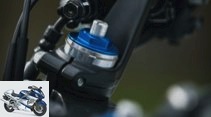
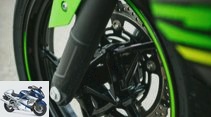
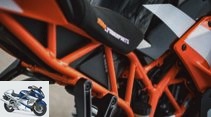
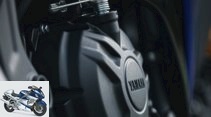
29 photos
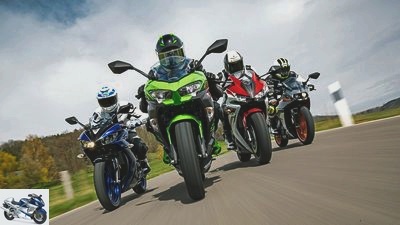
r-photography.info
1/29
Honda CBR 500 R, Kawasaki Ninja 400, KTM RC 390 and Yamaha YZF-R3 in comparison test.
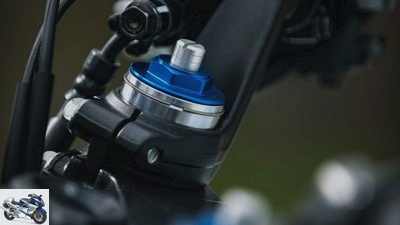
r-photography.info
2/29
Four bikes, four colors. Here blue but actually red, the Honda CBR 500 R..
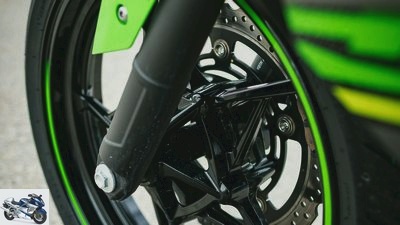
r-photography.info
3/29
Classic green – the Ninja 400 from Kawasaki.
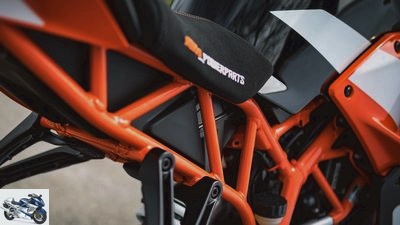
r-photography.info
4/29
Orange. What else is a KTM? The Rc 390.
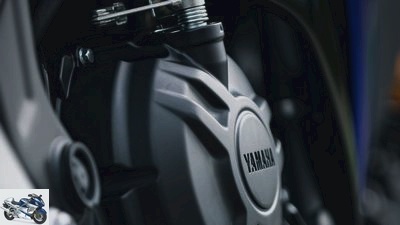
r-photography.info
5/29
The Yamaha YZF-R3 is shown in blue.
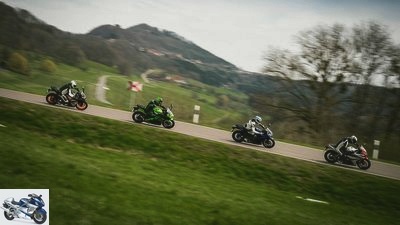
r-photography.info
6/29
Use momentum and then hit the shower.
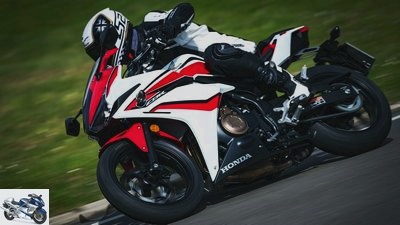
r-photography.info
7/29
Honda CBR 500 R….
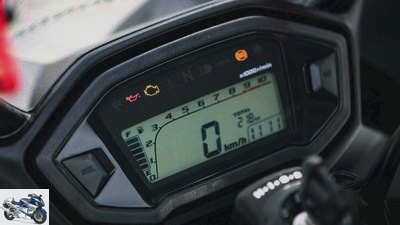
r-photography.info
8/29
Small cockpit in which the gear indicator is particularly missing.
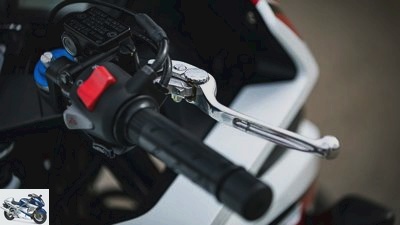
r-photography.info
9/29
Adjustable brake lever with great grip quality, fits well in the hand.
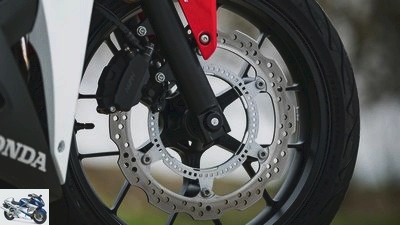
r-photography.info
10/29
320 wave disc, the effect of the floating saddles should be more research.
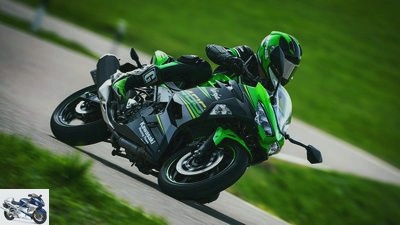
r-photography.info
11/29
Kawasaki Ninja 400…

r-photography.info
12/29
Kawa fans know the cockpit from the Ninja 650, large tachometer.
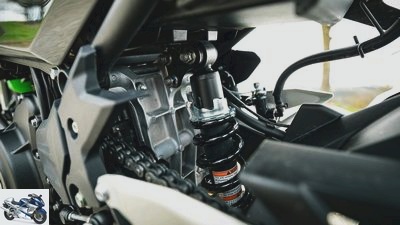
r-photography.info
13/29
Simple shock absorber – as with all – with easily accessible spring base preload.
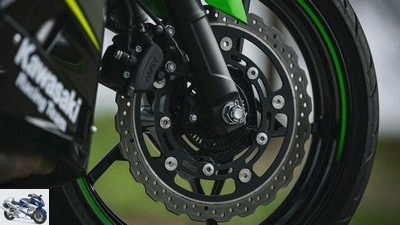
r-photography.info
14/29
Disc also in wave format, plus an axle secured with a split pin – typical Kawa.

r-photography.info
15/29
Lifted up: the MOTORRAD troop’s training vehicle.
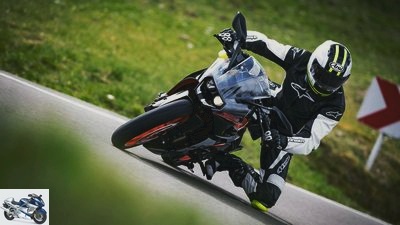
r-photography.info
16/29
KTM RC 390…
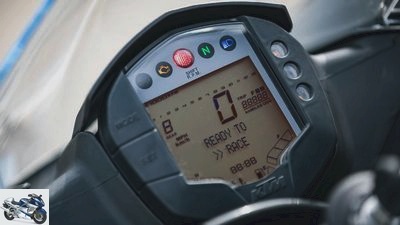
r-photography.info
17/29
Lots of information, but in a small format, a magnifying glass would be necessary.
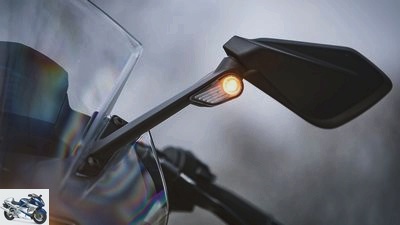
r-photography.info
18/29
Design element: the turn signals go into the mirror arms, nice detail.
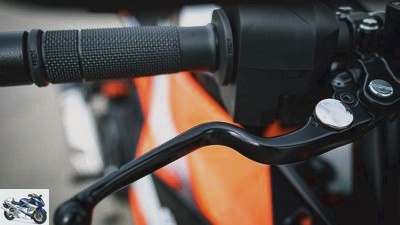
r-photography.info
19/29
Gladly seen: clutch and brake levers are adjustable.

r-photography.info
20/29
Yamaha YZF-R3…
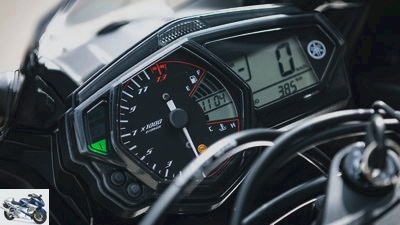
r-photography.info
21/29
The tachometer needle rotated 180 degrees means a feel-good area.
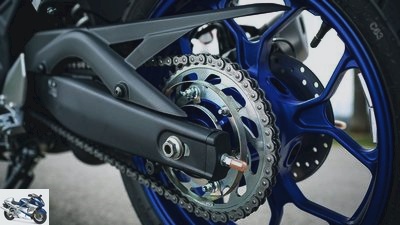
r-photography.info
22/29
Extra protection: the ring prevents the chain from jamming if it comes off.
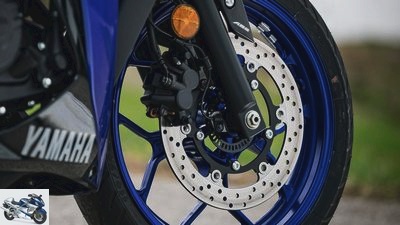
r-photography.info
23/29
At 298 millimeters, it is the smallest disc in comparison, so you have to grab hold of it.
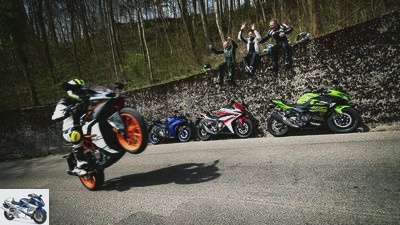
r-photography.info
24/29
Up the bike: a good mood guaranteed – with all fours.
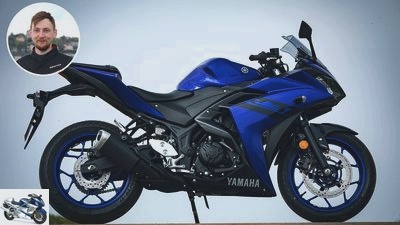
r-photography.info, Yvonne Hertler
25/29
Voices: “Long live the speed. It has to be in five digits, I’ll reach out to the Yamaha and let you in ”- Ferdinand Heinrich, intern
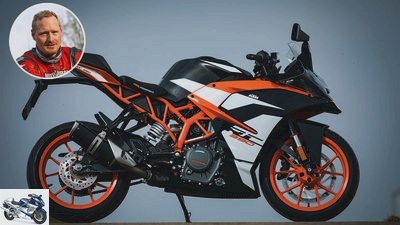
r-photography.info,
26/29
“Single-cylinder, sporty, with potential: My first choice comes from KTM from Austria” – Jens Moller-Tollner, editor
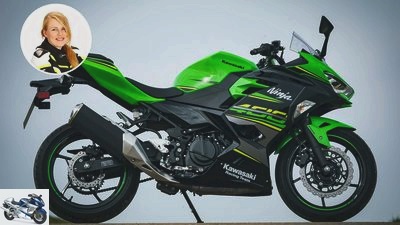
r-photography.info, factstudio.de
27/29
“I like the kawa. Gear indicator, anti-hopping clutch, great handling: great country road fun ”- Iris Schaber, assistant
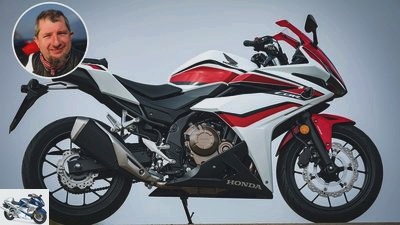
r-photography.info,
28/29
“Already noticed: The Honda can do everything and doesn’t pinch anywhere. Well-being is guaranteed ”- Georg Jelicic, top tester
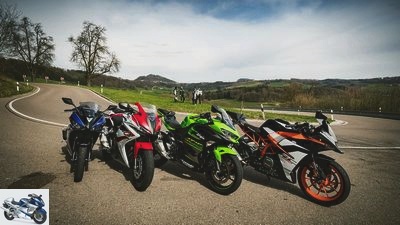
r-photography.info
29/29
The race ends with the Kawasaki Ninja 400. 2nd place goes to Honda, 3rd place to Yamaha. As a single cylinder, the KTM didn’t have it easy against the in-line twos. For them it will be 4th place.
Honda CBR 500 R, Kawasaki Ninja 400, KTM RC 390 and Yamaha YZF-R3
A2 athletes in the test
The new Kawasaki Ninja 400 is aiming for the top position among the A2 entry-level athletes. Whether their brisk appearance also offers a brisk being? A comparison with the Honda CBR 500 R, KTM RC 390 and Yamaha YZF-R3 models clarifies.
Fascinating super athletes. As soon as they scurry in front of the lens of someone contaminated with petrol, they catch glances. The pairing of a fast-paced look and a potent core simply has something. Which brings us to the current comparison. Of course, what I said last does not quite apply to him. Neither the Honda CBR 500 R nor Kawasaki’s Ninja 400, KTM’s RC 390 or Yamaha’s drive it with potency YZF-R3 too thick. Ultimately, they fall into the A2 grid, but with a maximum of 48 permitted horsepower they are fully suitable for beginners. And much more, because if you only define motorcycle fun in terms of engine power, you are missing out on a lot. The world of the four candidates means lightness, means controllability and means cheering and full throttle – mostly without conflicts with sheriffs and mobile or local photo booths.
Buy complete article
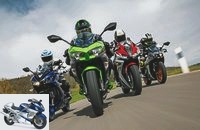
Honda CBR 500 R, Kawasaki Ninja 400, KTM RC 390 and Yamaha YZF-R3
A2 athletes in the test
Sufficient performance for everyday life
Of course there are still those who turn up their noses at their performance. With a measured 47 hp, the Kawasaki is at the top of the quartet. The KTM single has 44.5 hp, the Honda 44.1 and the Yamaha 40.4. The entry-level athlete of the Greens has been thoroughly revised for 2018. On the road as a 300 up until 2016, there was now more displacement, a front fairing based on the H2, a new fork and a new frame. If the Ninja 300 still had a steel bridge frame, a steel tubular tubular counterpart now supports the unit.
r-photography.info
From left to right: Yamaha YZF-R3, Honda CBR 500 R, Kawasaki Ninja 400 and KTM RC 390.
With the performance of the four, you can’t beat Fireblade and R1. But let’s be honest: You (almost) never need the power of the great super athletes in everyday life. A BMW S 1000 RR runs 141.8 km / h in first gear due to its power and the corresponding gear ratio. Probably everyone upshifts earlier, purring around most of the life of a two-wheeler with throttle valves not open because skill, traffic or speed limits no longer allow them. The first gears of the A2 athletes reach just over 50 km / h. If you want more, you have to switch gear, be ready for cheering engines. So much in advance: a pleasure.
So directly to the Honda CBR 500 R
At 800 millimeters, the seat height is nice and low. The feet find a secure hold. It gets even better with the seating arrangement. Is that supposed to be an athlete? It’s hard to believe, Honda put a lot of touring in the cradle of the CBR 500 R. The handlebars are well above the upper fork bridge and are pleasantly cranked. The notches placed deep for this relax the knee angle. The focus of the entry-level CBR is not the hottest round, but the longest, casual fun. It doesn’t get any more convenient or comfortable. This applies to the driver and the pillion passenger.
r-photography.info
The Honda CBR 500 R is quite suitable for touring.
Here today, there tomorrow and the day after tomorrow somewhere else: The 500cc two-cylinder Honda wakes you up with its great travel systems, it has the largest displacement with exactly 471 cm³, touring ambitions, is much closer to a VFR than a Fireblade. This is not only due to the front and rear seats, but also to the fundamental character of the CBR. With a full tank of 198 kilograms, the tank holds 15.7 liters, it weighs most of the kilos. The KTM weighs only 164 kilograms, the Ninja 400 only 170 and the R3 only 171 kilograms. In addition, the Honda has the longest wheelbase at 1410 millimeters, the flattest steering head angle at 64.5 degrees and the longest caster at 102 millimeters. These benchmarks are not only decisive for driving behavior, but they show a tendency, and that goes by the name of stability. Turn in the phone booth? No parade discipline of the Honda, a full cornering is. Your chassis has the greatest reserves, only sways slightly on mogul slopes, is stable and stoic.
CBR more tourers than athletes
Would a real hot spur be the right drive for such a motorcycle? Honda answered this question in the negative. So the two-cylinder underlines the tourist-sporting virtues of the CBR rather than complementing them with high-revving sportsmanship. Benefiting from the largest displacement, the small CBR starts up in a mannered manner even at the lowest engine speeds, runs calmly and calmly. If it needs to go faster, the engine will gladly follow this request, but not forever. At 9,000 rpm it is over, the revving power is exhausted. The End. Just as a brief comment: Even the single-cylinder KTM climbs the 10,000 mark on the tachometer, with the Kawasaki and Yamaha the limit is in the range of 12,000 tours.
r-photography.info
Unfortunately, the Honda CBR 500 R does not have a gear indicator.
For the Honda that means: Shifting, quickly shifting to the next gear in the transmission. In itself, the CBR does nothing wrong with this vote, but it refuses to accept the sporting spirit of the others a little. After all, you always have the feeling that more is possible, but the engine with the lowest compression at 10.7 to 1 is not allowed. Up to the 48 hp limit there would still be air. So it stays with the realization that the CBR 500 R is a damned adult motorcycle. A very convenient addition, more tourers than athletes. This goes with the generous range of 491 kilometers, thanks to the low 100 km consumption of 3.2 liters. The Yamaha also achieves this, the KTM has 3.3 liters, the Kawasaki 3.4 liters.
Kawa-Twin spoils you downstairs
The little more is one reason why the Ninja 400 is still in the tank after an impressive 412 kilometers. Then all 14 liters of gasoline are burned. And that in the truest sense of the word, because its two-cylinder turns out to be a speed-hungry lighter. Only shortly after 12,000 revolutions does the limiter cut the vigor of the 399 cm³ in-line twos. Just as a reminder: that‘s 3,000 tours more than the CBR 500 R! The Kawa-Twin spoils you downstairs with almost the same virtues as the Honda, runs only marginally more restless, hangs a tiny bit worse on the gas. Just enough that one can speak of a difference. This is clearer with the clutch: one finger is enough and the flow of power is interrupted. Great. In addition, the standard anti-hopping clutch effectively prevents a stamping rear wheel when downshifting.
r-photography.info
With 47.2 hp, the Kawasaki offers the most power in this test field.
Which is not so unimportant, after all, the Kawa is always the first to dash towards the next braking point. None of the four is faster. It converts most of the power (47.2 hp) and the enormous torque into the best driving performance. Except for the sprint to 100 km / h. The KTM takes a tenth off her and breaks the mark after just 5.2 seconds. The kawa needs a touch more. For free. Because the Kawasaki gives the curve weasel. Tighter, faster, easier to turn around the corner, folded down until the knee sliders grate across the asphalt? The ninja shows how it’s done. To put a stop to doubters: Of course nobody has to drive on winding country roads like that, but it is great fun. And anyone who has ever brought his knee to the ground knows exactly what a great feeling it was.
The old Ninja 300 is forgotten
With the sitting position, the Kawasaki invites you to do sporty gymnastics as well as a leisurely round of the house, with the handlebar stubs attached above the upper fork bridge and the not too sporty attached pegs, it makes a good compromise between speed and comfort. There are only deductions for the seat cushion. That hurts the butt after less than 200 kilometers in a row. With the brisk swing that doesn’t matter, because the motor together with the Samba-nimble nature of the Kawa immediately ensures that the corners of the mouth are drawn up again.
r-photography.info
Kawa fans know the cockpit of the Ninja 650.
Although the ninja with its light-footed chassis doesn’t quite come close to the stability of the Honda, it could do with a better response and a little more damping at the rear, but in total it masters all the demands on bends. And that even in the dark, because the ninja driver can rely on the great double headlights at night. White LED light from both sides floods the street, inspires confidence. Everything done right, Kawasaki. The old Ninja 300 is forgotten. The new, larger engine and the sensible fine-tuning of the frame and the equipment (new cockpit, new fairing) are guarantees for the success of the Greens. Because: The Ninja 400 came and won, pushing itself to first place. Why? Let’s take a look at the KTM after CBR and Ninja.
How is the KTM Rc 390 doing?
The RC 390 embodies the most radical approach in this test field. Do you want sport? You can get it here. The stubs are attached to the upper fork bridge, the notches are high and at the back, the tank with a capacity of only ten liters offers the narrowest knee joint. No other motorcycle claims more racing among the A2 athletes. The single cylinder fits like a fist on the eye. Running noticeably bumpy below, especially in the higher gears, it feels at home in the second half of the engine speed and likes to turn with ease up to the limiter. The only stops the thirst for action of the 373 cm³ single at a good 10200 rpm. In addition, the shift light flickers in disco-strobe-light fashion from the cockpit, vying for attention. A good thing, because even eagle eyes in their early twenties can barely read the information and especially the tachometer. Everything too small.
r-photography.info
KTM’s focus on sportiness costs points in the comfort and range disciplines.
Presbyopia finally puts a stop to this. So quickly put the next gear up when the warning light flickers for the first time. Since the power interruption is as easy as on the Kawa, the next pair of gears quickly find each other. The reward for the nimble switching effort? Fleet performance that is on par with the Honda due to its low weight of only 164 kilograms. In real life, the Nippon-two sees the cheeky rear light of the Austria single more often than he would like. The joy of turning, we’ve already had it. What the KTM lacks in terms of its great sportiness, however, is a well-positioned chassis. The mounted M5 from Metzeler grip well, but they are not easy to use when they are inclined. The tail gauts too much, the fork sags too much when stopping. There would be more. Nevertheless: This radical approach turns on and arouses the KTM driver’s drive for sport in no time at all. The strong focus on sportiness costs points, however, because comfort and, for example, the range due to the small tank are not too great.
Last but not least: Yamaha YZF-R3
Drive for a long time, so the Yamaha YZF-R3 can serve you. 438 kilometers are a word because your tank also holds 14 liters. But it is rather the sheer smallness that stands out most about the Yamaha. The seating position on no other motorcycle is more compact. With its high clip-on handlebars, it is not as sporty as the KTM. But: The handlebars are far inwards, the distance to the seat, which is only 780 millimeters high, greets you with brevity. In addition, the notches are hinged at the top in a tilt-friendly manner, and it says: Please fold up. Anyone who exceeds 180 centimeters feels like a giant who is supposed to balance on a pea. With a little practice it works, but there is no feel-good atmosphere. So rather positively formulated: Lutte will love the R3.
r-photography.info
The Yamaha YZF-R3 has the smallest motor in this test.
But they have to make their peace with the smallest engine in the quartet. The 321 cc twin wants and needs speeds. The best thing to do is to always point the needle vertically upwards on the easy-to-read tachometer, then you go forward. Between 9,000 rpm and the governing speed just before 12,000 revolutions, the two feels most comfortable. The Yamaha embodies even more sport than the KTM when it comes to engines. And as with this one, your chassis would need more damping for the rapid cornering. It lies comfortably, but allows a little too much movement. The rear wheel tends to lock when downshifting in the precise gearbox, especially when downhill. In the absence of an anti-hopping clutch and chassis reserves, only double-declutching helps so that the rear tire stays on its lane more smoothly. They hit all four when it comes to braking. Supported by ABS, they provide adequate deceleration values. The Honda control intervals block the bike at most a touch too long. It is also clear that a firm hold requires high forces, rather the whole hand than just two fingers. The last braking is already a curve back, the apex just sweeps past – full throttle. Without pitfalls and twitching wheels – just great, such jubilee days.
MOTORCYCLE test result
1. Kawasaki Ninja 400
What a debut. The Ninja 400 moves directly to number one. The basis for this? An engine that feels at home in the entire rev range, and a chassis that combines handiness and stability at a high level.
2. Honda CBR 500 R
The abbreviation CBR in the name suggests sportiness. A small fallacy, because the Honda 500 is more of a great sports tourer. The quietest drive, plenty of space, comfortable upholstery – comfort is a top priority for the CBR.
3. Yamaha YZF-R3
The smallest engine in the test field tries its best, is a capricious high-rev. With its compact dimensions, the R3 is the sporty entry-level recommendation for people clearly under the guard. They only find a tight spot on it.
4. KTM RC 390
The single-cylinder doesn’t have it easy against the in-line twos. But he does more than brave. No other offers a more sporty ergonomics, but the spring elements should have more cushioning for brisk, inclined pleasure.
Related articles
-
Kawasaki Z 800, Yamaha MT-09 and BMW F 800 R in a comparison test
35 photos 1/35 The center is no longer where it used to be. Because bikes with displacements around 800 cm³…
-
Honda CBR 300 R, Kawasaki Ninja 300, KTM RC 390 and Yamaha YZF-R3 in the test
Bilski 24 photos Bilski 1/24 If four race-proven testers grin happily ever after a day on the slopes instead of exhausted gasping for air, it could be…
-
Kawasaki Ninja 300, KTM RC 390, Honda CBR 300 R and Yamaha YZF-R3 in the test
markus-jahn.com 42 photos markus-jahn.com 1/42 Four bikes compete to compare the third-liter athletes. markus-jahn.com 2/42 The Honda fork also responds…
-
Honda CB 1000 R, Kawasaki Z 1000 SE, Yamaha FZ1 in the test
www. 48 photos www. 1/48 On the MOTORRAD test tracks in southern France, Honda’s CB 1000 R and Yamaha’s FZ1 are ready to test…
-
Ducati 1299 Panigale S and Kawasaki Ninja H2 in comparison test
31 photos 1/31 On the left in the picture 197 PS and 145 Nm (Ducati 1299 Panigale S), on the right there are 200 PS and 133 Nm…
-
Suzuki Hayabusa, Kawasaki Ninja H2, Aprilia RSV4 RF and Yamaha Vmax in the test
Bilski 41 photos Bilski 1/41 Yamaha Vmax, Suzuki Hayabusa, Aprilia RSV4 RF, Kawasaki Ninja H2. Each of these four machines has its own special charm….
-
Aprilia Tuono V4 1100 RR, Kawasaki Ninja H2 and BMW S 1000 XR in the comparison test
Arturo Rivas Gonzalez 31 photos Arturo Rivas Gonzalez 1/31 Aprilia Tuono V4 1100 RR, Kawasaki Ninja H2 and BMW S 1000 XR. Arturo Rivas Gonzalez 2/31 And…
-
fact Concept comparison Honda CBR 1100 XX Kawasaki ZX-12 R Suzuki GSX-R 1000 Suzuki GSX 1400 Yamaha FZS 1000 Fazer Yamaha FJR 1300 Six bombs The six most…
-
Comparison test BMW S 1000 RR, Kawasaki ZX-10R and Yamaha YZF-R1M
22nd photos 1/22 BMW S 1000 RR, Kawasaki Ninja ZX-10R and Yamaha YZF-R1M. 2/22 Yamaha YZF-R1M. 3/22…
-
BMW, Honda, Kawasaki, Suzuki and Yamaha super sports cars in a comparison test
Judd 26th photos Nicolaou 1/26 In the supersports comparison test: Kawasaki ZX-10R, BMW S 1000 RR, Suzuki GSX-R 1000, Honda Fireblade C-ABS and Yamaha…